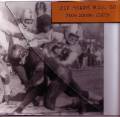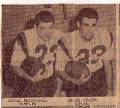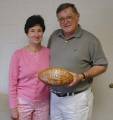

- Anne Hale: The Case of the Communist Teacher
- Baseball: A Way of Life
- Chuck Taylor Hightops: WHS Basketball
- The Baby Boom Explodes
- "Mrs. Everywoman"
- Warriors Football
- Nightlife Up in Smoke: The Mansion Inn
- Not-So-Fast-Times at Wayland High
- The Sirens of Wayland: The Police Department
- Cold War Wayland: Nike Missile Site & Raytheon
- Keeping Up wit the Joneses: Consumerism in the Town Crier
- A Sense of Community: The Strawberry Festival
- Newsletters to Those at War: The Bugle and the Jeep
- A Quieter Life: Coming Home from World War II
- Duty Calls: Veterans of the Korean War
- A Simpler Time: Growing Up in Wayland
- Old Meets New: Dudley Pond
- Flash Movie
Warrior Pride 50's Style: WHS Football
The 1950's are seen as one of the most positive and influential decades of modern
 American History. The nation was largely united by patriotism and anti-communism, and while it was a conservative time, progressives sought to improve the social problems through actions of the famed Civil Rights Movement. This decade also brought a massive population boom nationwide. Much of this was felt in our small town of Wayland. The high school grew in size, and the town expanded to about 8,000 people. Among the various divisions within the high school and the town, competitive athletics became a popular activity.
American History. The nation was largely united by patriotism and anti-communism, and while it was a conservative time, progressives sought to improve the social problems through actions of the famed Civil Rights Movement. This decade also brought a massive population boom nationwide. Much of this was felt in our small town of Wayland. The high school grew in size, and the town expanded to about 8,000 people. Among the various divisions within the high school and the town, competitive athletics became a popular activity. As the population continued to grow, more people flocked to the town. Football eventually became one of the largest social focal points for Wayland. Nationally, American football still hadn't gained lots of popularity, but it was certainly on the rise. Small towns like Wayland began to adopt this sport. Football involved hard work and commitment in the hopes of
 creating winning teams and long-lasting team glory.
They also adopted the two other major sports during the winter and spring: basketball and baseball. Of all 3 sports, football was considered most distinguished to be an all-star on the football team. Like the football team of today, they had double session practices late in the summer, even before school started. They worked very hard as a unit to dominate surrounding towns and put themselves on top.
creating winning teams and long-lasting team glory.
They also adopted the two other major sports during the winter and spring: basketball and baseball. Of all 3 sports, football was considered most distinguished to be an all-star on the football team. Like the football team of today, they had double session practices late in the summer, even before school started. They worked very hard as a unit to dominate surrounding towns and put themselves on top. However, unlike the present day Wayland Warrior football squad, the 1950's Wayland Warriors were an unstoppable force in the MetroWest (pre-DCL) league. They were undefeated for several straight years and always managed to best their Weston arch-rivals. They could attribute lots of their success to their hard working, blue-collar kids, but also mainly to their coach, Ralph Salvatti. Ralph Salvatti is described as a Vince Lombardi type; a highly motivational coach who pushed his players to their peak. He accepted nothing less then 110% from his players on game day. The team practiced nearly six times a week, and held in-depth film sessions on Mondays.
 The intensity of their practices, depended upon their level of play during the previous game, or according to whatever mishaps the game tape had to reveal. Excruciating as these practices may seem, they obviously worked because Wayland dominated the league though out the 1950's.
The intensity of their practices, depended upon their level of play during the previous game, or according to whatever mishaps the game tape had to reveal. Excruciating as these practices may seem, they obviously worked because Wayland dominated the league though out the 1950's. Dick Morris, an all-star Wayland player that played football throughout high school career, described the Wayland Warrior football team as "...the 358s vs. the 653s." The "653s" were the first

 three digits of the extensions for Cochituate telephone numbers, and the "358" extension belonged primarily to the Northies, who lived north of the high school, which is now the town building. There was this feud because Wayland was split nearly down the middle, where you had the richer-class Northies who were all very well off, yet hardly produced any real athletes.
three digits of the extensions for Cochituate telephone numbers, and the "358" extension belonged primarily to the Northies, who lived north of the high school, which is now the town building. There was this feud because Wayland was split nearly down the middle, where you had the richer-class Northies who were all very well off, yet hardly produced any real athletes. However, "the real athletic talent", Dick said, "could be found within the blue-collar boys from Cochichuate," who were very representative of teenage youth during the 50's. They were spunky, suave, and full of rich competitiveness that they may have adopted from their parents, whom were largely war veterans. They generally had to work intensely to achieve things in life, in school, and especially in athletics. They worked hard, perhaps unlike the Northies, who more often had everything already set for them, and found great payoff in their efforts. For them, football represented something that they had to work hard at to excel in because they had the inner drive to be champions. It was this inner drive that led Wayland football on a large winning streak throughout the 1950s and beyond.
Q: What years did you play football?
A: I played 1956 through 1959. I was the graduating class of '60.
Q: What league did you play in?
A: We were in the Dual County League, which had just come out in the 50's. We played Ashland, Bedford, all those guys. We played a 9-10 game schedule, and fortunately while I was there, we never lost a game, but we did tie one.
Q: Where did you play your home games?
A: We played all our games on our high school field, which is presently town center.
Q: Did you guys have pretty big turnouts?
A: Well, at that time the population of the town was probably around 5, 000 people. The turnout would be 3-400 at a game. It was real popular.
Q: How did the football team rank back in the 50's?
A: Well, to say the least, we were always #1. We were a dominating force. We won 44 straight games in a row. They always said that we were supposed to be so great, that we could of beaten Natick any day, and they had 65 kids, while we only had about 14 of us. We used to go both ways--it was tough.
Q: Could you attribute any of that to a particular reason?
They had a bunch of good horses back then. There were a lot of blue-collar kids growing up. There was a big division in town, it was the 653's vs. the 358's. The Cochichuate boys against the Northies. We just happened to have a bunch of good athletes back in the day. The training was intense, from when we were 10 years old, and the other kids didn't.
Q: Who was your coach, and what was his mentality?
A: Our coach was Ralph Salvatti, who coached from '52 till the '70s. He eventually became the athletic director. He had the mentality of a guy like Vince Lombardi. That was it. You didn't have to know that many plays. All you had to do was execute, and execute well. Conditioning was a big thing, you went both ways. We had double sessions; it was tough. If you were a captain, there was an even bigger responsibility. You barely even got water during practice or during the games. If you broke a play and things didn't go well, you just kept goin' until he blew the whistle. He'd just call you back and tell you "let's run it again". He was well liked, but we was well feared, too. He was the "winningest" coach in the state of Mass. He built a lot of character in a lot of people. Even people I see today, they still speak highly of him.
Q: How much was the football team part of the school/town social scene?
A: We had only 3 sports: baseball, basketball, and football. Football was the number one thing to do. It was sorta like the jocks who got priority over other stuff, and that kinda thing. The town always got excited about us. We got a lot of public attention, the press and everything. At school everyone would talk about the team. We had rallies and everything. We also just got a ton of support from everybody.
Q: So was it still the stereotypical "football player dates cheerleader" world?
A: (Laughs) Yeah, I guess it was sort of like that. There was quite a few of my football buddies that dated cheerleaders. Even my girlfriend was the captain of the cheerleading team, and I was captain of football, so it just sorta worked out. We ended up getting married, after all. We were pretty well respected.
Q: Did the whole team hang out or party as a group?
A: The Mansion Inn was sort of popluar, but the kids couldn't go in because they served alcohol. We had our little areas here and there, down by the pond. There was one place called "Vestouchi's" down in some private area. Guys were just talkin about the game or whatever. It was fun.
Q: How did the population growth affect football.
A: It was about 4-5 thousand during the middle fifties, and there were a lot more guys on the team. Things got more crowded--you had to keep you cows off the street.
Q: How many players where on the team?
A: About 14 of us. We had to go both ways.
Q: How was the town/team/school affected by the Korean/post-WW2?
A: A lot of kids of veterans were playing sports during the time.
Q: What was the atmosphere in town with regards to the communist (RED) threat?
A: We were young at that age. I remember talking about it in school, but it never really affected us much.
Q: How did the introduction of the television/advanced media impact the game of football town/nation wide?
A: We began to record our games on tape, just like the one you saw. A guy named Androtti did it. We watched the film on Monday and we'd get the day off. It all depended on what the film showed. If it was ugly, we'd be out there workin'.



